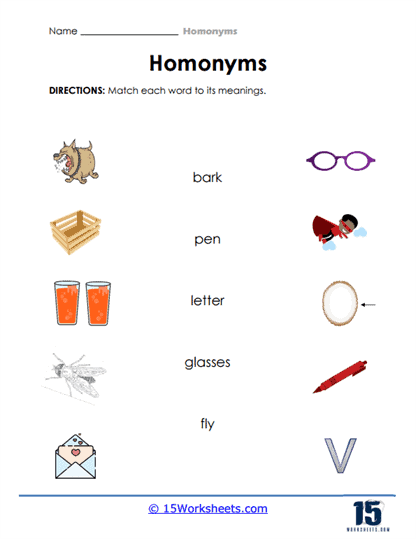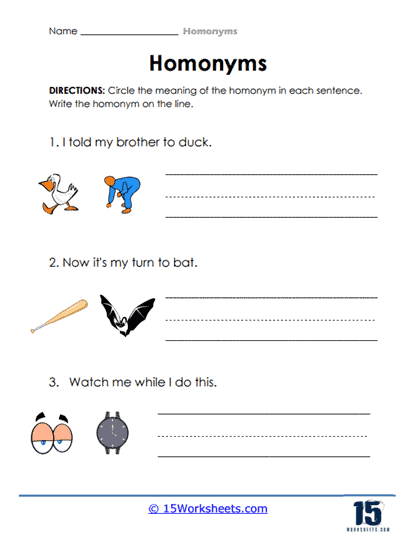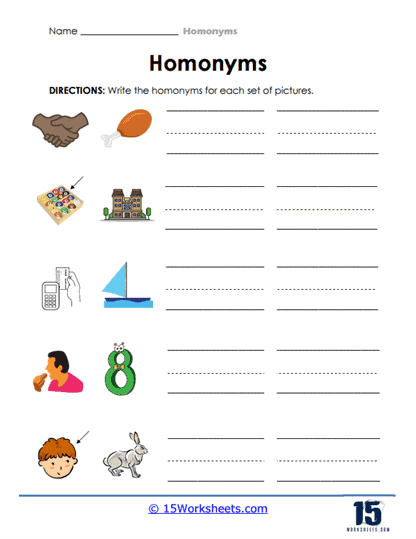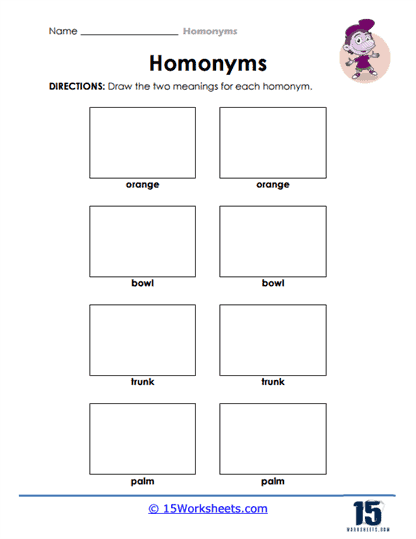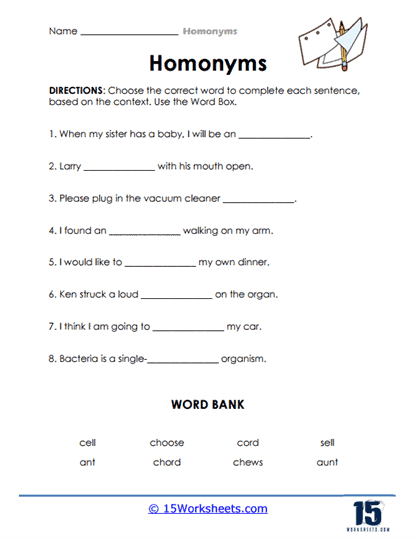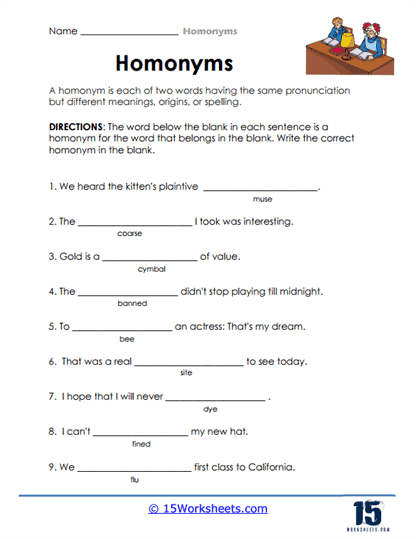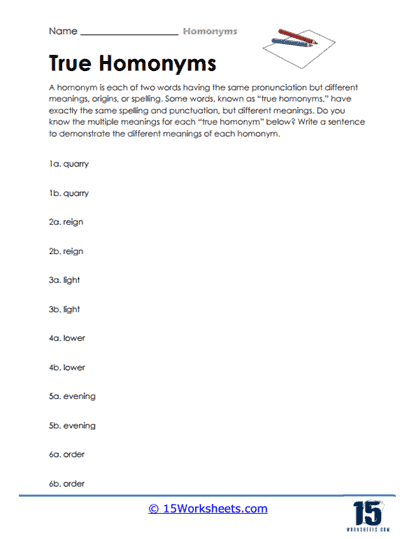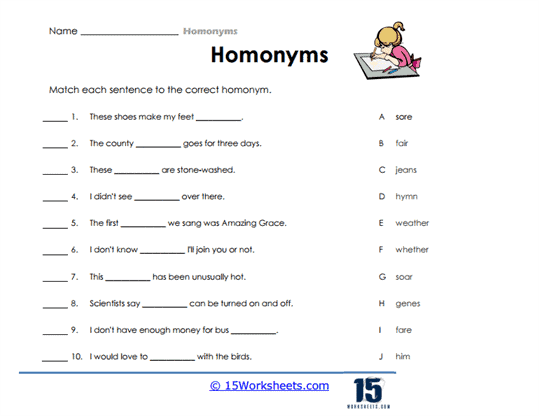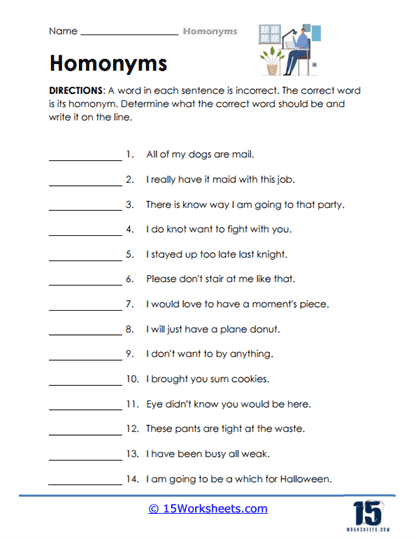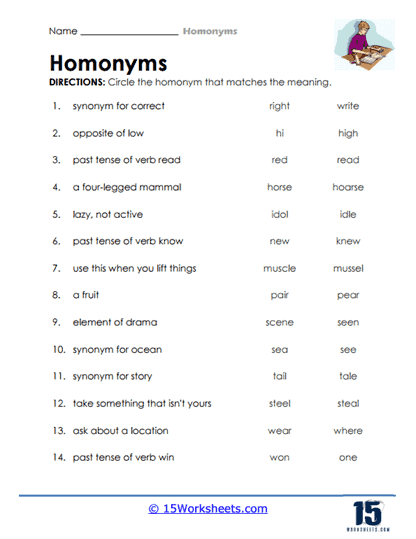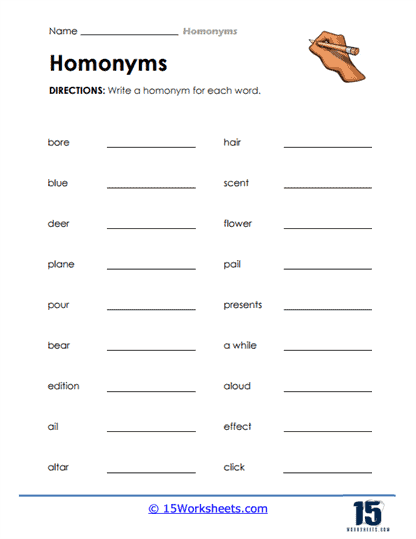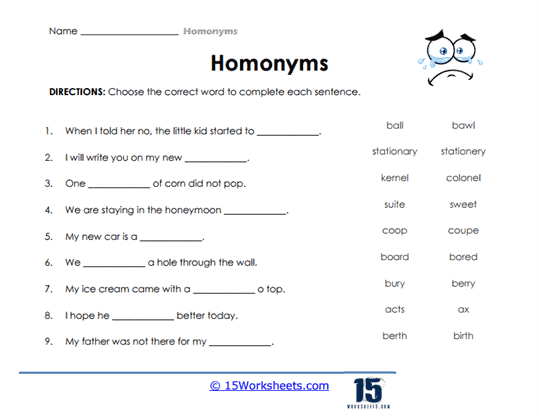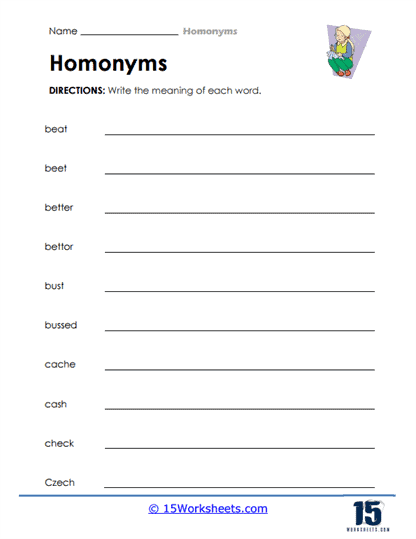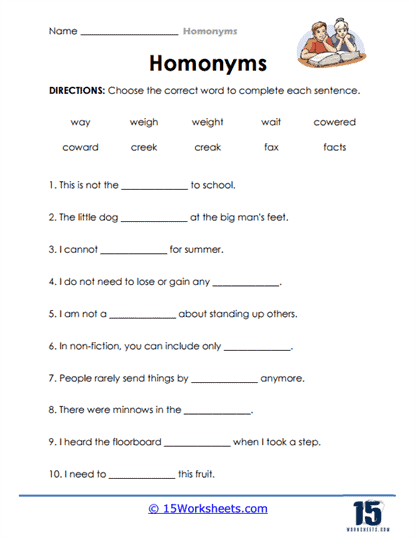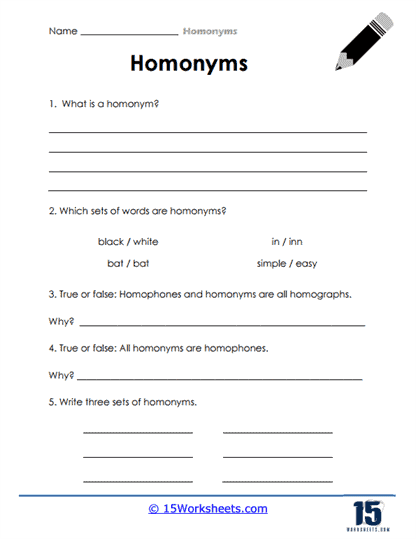Homonyms Worksheets
All About These 15 Worksheets
Homonyms, those fascinating words that share the same spelling and pronunciation but carry entirely different meanings, can be a source of confusion for learners of any age. Mastering the use of homonyms is a critical skill in English language learning, as it sharpens one’s ability to discern subtle differences in meaning and context. That’s where targeted practice comes into play. The collection of homonyms worksheets is designed to address this very challenge, offering a variety of engaging exercises that not only help students identify homonyms but also deepen their understanding of how to use them correctly.
One of the most powerful aspects of these worksheets is the way they invite students to actively engage with language. These aren’t just simple fill-in-the-blank exercises—each worksheet is crafted to challenge students to think critically about the meanings of words, the nuances of context, and how language can shift depending on usage. For example, students might be tasked with matching a homonym to its correct definition or identifying the right homonym based on the context of a sentence. By doing so, they begin to develop a sharper sense of word choice, which is an invaluable skill in both written and spoken communication.
Consider a typical scenario in one of the worksheets: the word “bat.” Depending on the context, “bat” could refer to a piece of sports equipment used in baseball, or it might signify the flying mammal often seen at dusk. Through exercises that require students to fill in the correct homonym, they learn to pause, consider the surrounding words, and make an informed choice about which meaning fits best. This kind of attention to detail not only improves their vocabulary but also encourages a more careful approach to communication, reducing the likelihood of misunderstandings in the future.
Another example might involve the homonym “bank.” Is the worksheet referring to the financial institution where people keep their money, or is it discussing the sloping land beside a river? By prompting students to select the correct homonym, these exercises provide an opportunity to think about how different meanings can emerge from the same word, depending on the situation. As students work through these exercises, they develop a more intuitive understanding of language, which can dramatically improve their reading comprehension skills. After all, the more quickly and accurately a person can interpret meaning from context, the more fluent they become.
The benefits of these homonym worksheets extend beyond mere word recognition. In addition to identifying homonyms, students are encouraged to create their own sentences using these words in the correct context. This reinforces their learning, as it requires them to not only understand the different meanings but also apply them in a meaningful way. For instance, a student may be asked to write one sentence using “bat” as the sports equipment and another sentence using “bat” as the animal. This dual application strengthens their grasp of homonyms and enhances their overall writing skills, making them more versatile in their expression.
Spotting and correcting errors is another crucial component of these worksheets. Often, students are presented with sentences where an incorrect homonym has been used, and their task is to identify and fix the mistake. This exercise not only reinforces their understanding of the correct meanings but also cultivates an essential proofreading skill. Imagine a sentence like, “She withdrew money from the river bank.” It’s clear that there’s a mix-up, and the student must correct it to, “She withdrew money from the bank.” Such exercises make students more attuned to common mistakes and help them avoid similar errors in their own writing.
The writing prompts included in the worksheets serve as an excellent tool for deeper exploration of homonyms. These prompts challenge students to think critically about the form and function of homonyms in the English language. For instance, a prompt might ask students to explain why homonyms exist and how their use can sometimes lead to humorous or confusing situations in daily life. By reflecting on these questions, students gain a deeper appreciation for the richness of the English language and the importance of context when communicating effectively.
By engaging in these activities, students become more adept at identifying and using homonyms correctly, which enhances their overall communication abilities. They learn to pay closer attention to context, become more proficient in error detection, and gain confidence in their writing. These worksheets not only make learning about homonyms fun and interactive, but they also equip students with the skills they need to navigate the complexities of the English language with ease and precision.
What are Homonyms?
Homonyms are words that have the same spelling and pronunciation but have different meanings. They can be confusing for English learners and even native speakers, especially when used incorrectly in a sentence. Here are some examples of commonly used homonyms:
- “Bat” (an animal) and “bat” (a piece of sports equipment)
- “Bear” (an animal) and “bear” (to carry or tolerate)
- “Fair” (just and impartial) and “fair” (an event or carnival)
- “Bank” (a financial institution) and “bank” (the edge of a river)
To spot a sentence that uses homonyms incorrectly, you can look for errors in context or meaning that result in the sentence not making sense or conveying the intended meaning. Here are some examples:
- Incorrect: I saw a bat at the fair last night.
- Correct: I saw a bat at the baseball game last night.
In this example, “fair” is used incorrectly and should be replaced with “baseball game” to convey the intended meaning.
- Incorrect: I need to bear money from the bank.
- Correct: I need to withdraw money from the bank.
In this example, “bear” is used incorrectly and should be replaced with “withdraw” to convey the intended meaning.
Overall, spotting incorrectly used homonyms in a sentence involves understanding the context and intended meaning of the sentence, as well as recognizing the proper usage of each homonym. Knowing the differences between commonly used homonyms is an essential part of English language proficiency.
Homonyms vs. Homophones
Homonyms and homophones are both types of words that can be confusing for English learners, but they have different definitions.
- Homonyms are words that have the same spelling and pronunciation, but different meanings. For example, “bat” can refer to an animal or a piece of sports equipment, and “bank” can refer to a financial institution or the edge of a river.
- Homophones, on the other hand, are words that sound the same, but have different spellings and meanings. For example, “to,” “too,” and “two” all sound the same, but are spelled differently and have different meanings.
In summary, homonyms are words that are spelled and pronounced the same but have different meanings, while homophones are words that sound the same but are spelled differently and have different meanings.

